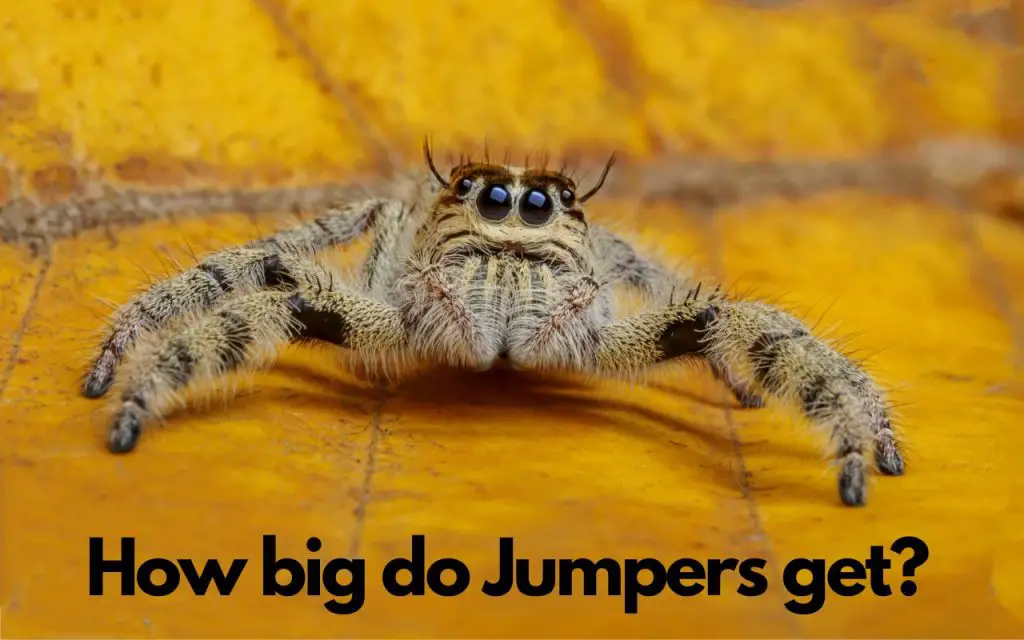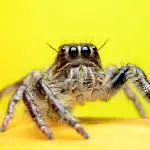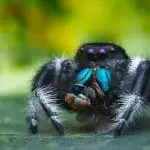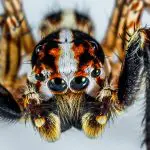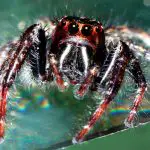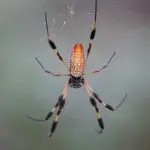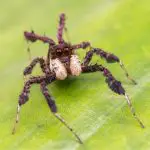A mature jumping spider’s size varies from about 0.08 to 0.87 inches (2 to 22 mm). However, most of them are between small to medium sizes. The family Oonopidae has the smallest jumping spider species and is common in the tropics.
Jumping spiders belong to the family salticidae and are well-known for jumping and pouncing on their prey. They inhabit mostly the tropic regions but you can also find them in the arctic and northern regions. The majority of the jumping spider species are furless, but a few have hairy bodies.
Average Jumping Spider size
A jumping spider can grow to an average size of about 0.5 inches. While some species in this family grow up to 0.87 inches, most only reach the small and medium limits. Members of the Bahgeera Kiplingi species are amongst the smallest in the family, their size ranging between 5 to 6 mm.
In addition, the males have a smaller abdomen than the females, making it easier to distinguish them.
The Top 5 Largest Jumping Spiders
Jumping spiders comprise the largest percentage of the spider population with more than 6000 species (that we know about). They can live comfortably in various habitats worldwide, except on the south and north poles. Furthermore, you can distinguish the species from their sizes as members of each species have a specific size range.
Below are the top five largest jumping spiders:
- The Giant Jumping Spider (Hyllus giganteus)
- Heavy Jumping Spider (Hyllus Diardi)
- Regal Jumping Spider (Phidippus regius)
- Bold Jumping Spider (Phidippus audax)
- The Emerald Jumping Spider (Paraphidippus aurantius)
1. The Giant Jumping Spider (Hyllus giganteus)
The giant jumping spider is the largest species in the family. Carl Ludwing Koch, a German scientist, discovered the first giant jumper in 1846. They are native to Australia and Samatra where they dwell mostly on trees in thick forests.
You can tell a giant jumper from other species with its bright colors including blue, green, and red. They also have a remarkable eyesight that enable them to differentiate colors. In addition, they are day-hunters and mostly prey on other spiders, mealworms, and flies. The females are larger than the males, but the latter compensate for this by displaying their bright colors.
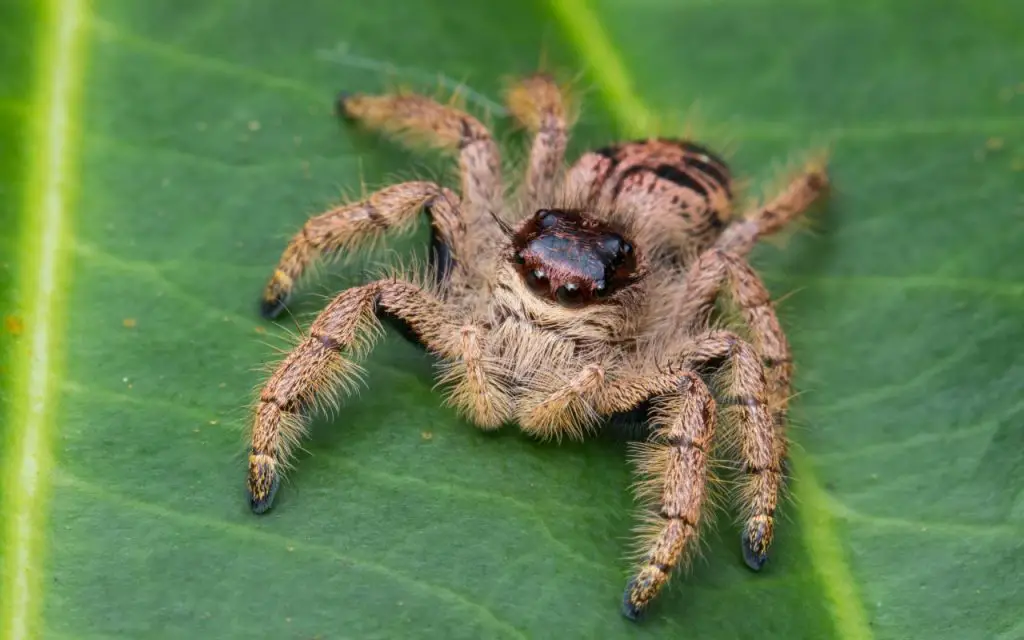
2. Heavy Jumping Spider (Hyllus Diardi)
Also known as semi-coppered heavy jumping spider, heavy jumping spider is native to Pakistan, Sri Lanka, and India. These creatures have tipped legs and black stripes on their yellow bodies.
The male heavy jumpers are about 7.8 mm in size and are slightly smaller than the females who are about 8.9mm. They make heavy silken webs under coconut leaves as they love to inhabit coconut tree trunks.
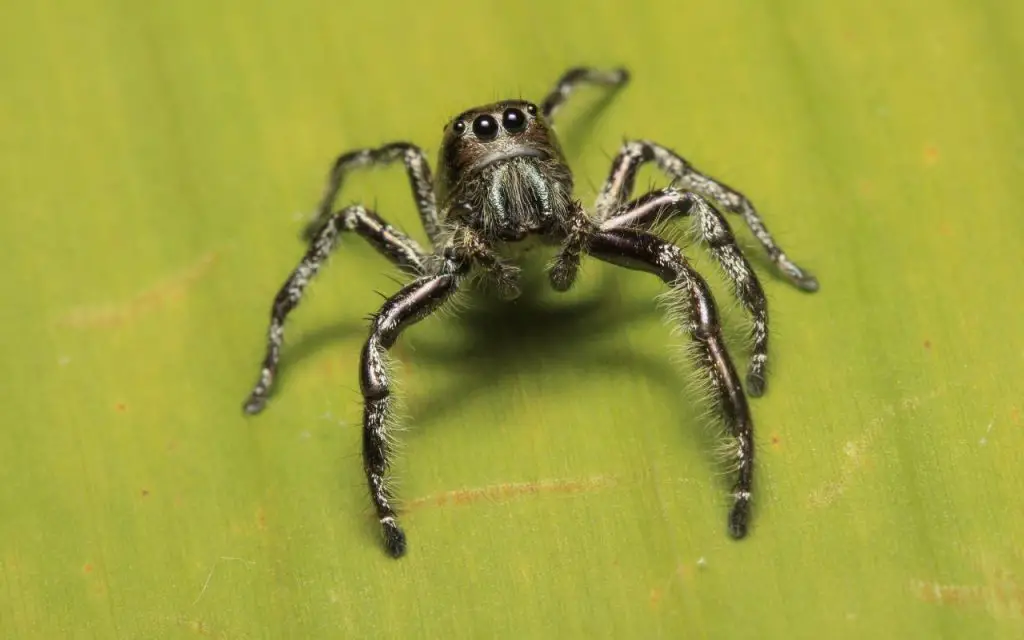
3. Regal Jumping Spider (Phidippus regius)
The regal jumping spider is one of the largest species you can find in eastern North America. While many people fear spiders, the Phidippus regius will likely become your favorite due to its calm nature. Actually, some natives keep these creatures in their homes as pets.
They are common in woodlands and dense fields, but sometimes you may spot them crawling on your walls. Moreover, they leave a trail line behind them so that they do not fall whenever they miss a jump.
The male regal jumper can be smaller than the female, about 6 to 18 mm and 7 to 22 mm respectively. Nonetheless, this is not a constant rule. Again, you can easily tell the two apart since the male has unique features such as blue or green fangs combined with white or black colors.
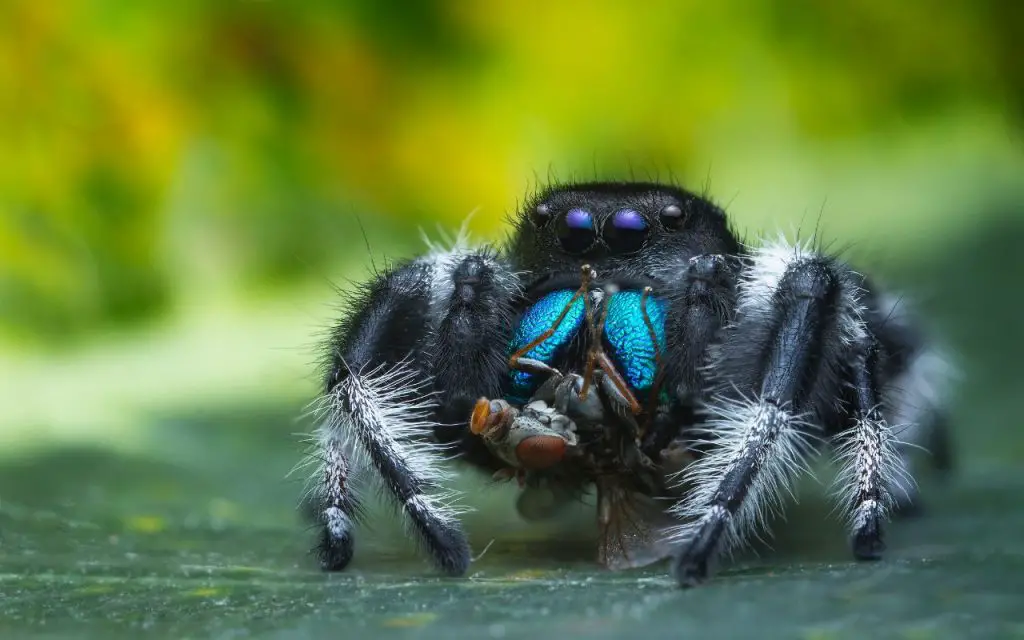
4. Bold Jumping Spider (Phidippus audax)
The bold jumper is mainly native to North America. You will likely encounter this species around your home. Moreover, it is easy to spot due to its large size. Again, they have the best eyesight to spot their prey, thanks to their four pairs of eyes.
Bold jumpers are day-hunters and prefer to move alone. Therefore, the sharp vision is the biggest advantage they have since they use it to observe predator and prey. Additionally, they also use visual communication in reproduction where the males lift their legs as a signal to attract the females.
Furthermore, their bodies are hairy and the female is larger than the male; 8 to 15 mm long and 6 to 13 mm long respectively.
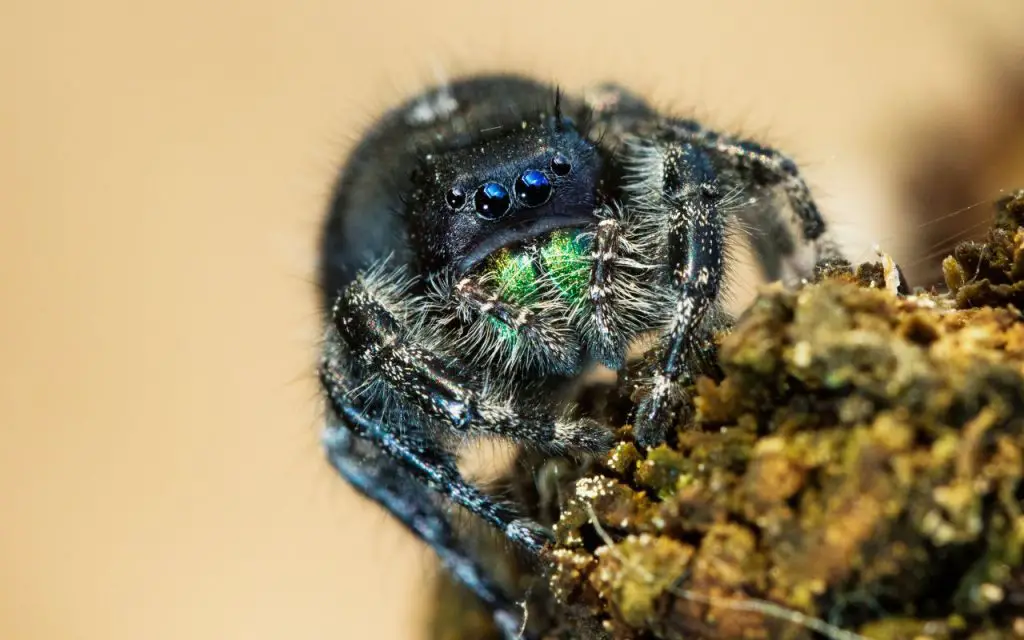
5. The Emerald Jumping Spider (Paraphidippus aurantius)
It is a solitary jumping spider common across various parts of the U.S like Maryland and Virginia. You can distinguish the male from the female with the white border on its abdomen and the white stripes on both sides of its head. On the contrary, the female has a brown color with deep orange details.
These spiders are harmless, but they can bite under threat. Nevertheless, while the bite might sting a bit, it cannot cause any serious alarm. The female ones are larger, ranging from 8 to 12 mm long. The males range between 7 to 10 mm long.
The Top 5 Small Jumping Spiders
The top 5 small jumping spiders include:
- The Zebra Jumping Spider (Salticus scenicus)
- Green Jumper (Lyssomanes viridis)
- Cardinal Jumper (Phidippus cardinalis)
- Red-backed Jumping Spider (Phidippus johnsoni)
- Shiny Jumping Spider (Cosmophasis Umbratica)
1. The Zebra Jumping Spider (Salticus scenicus)
These jumpers earn their name from the white and black stripes on their backs and live mostly in the Northern Hemisphere. They have four pairs of eyes with the middle one being the largest.
The female zebra jumpers grow to about 5 to 9 mm while the males reach 5 to 6 mm. Nonetheless, the males possess larger chelicerae than their female counterparts.
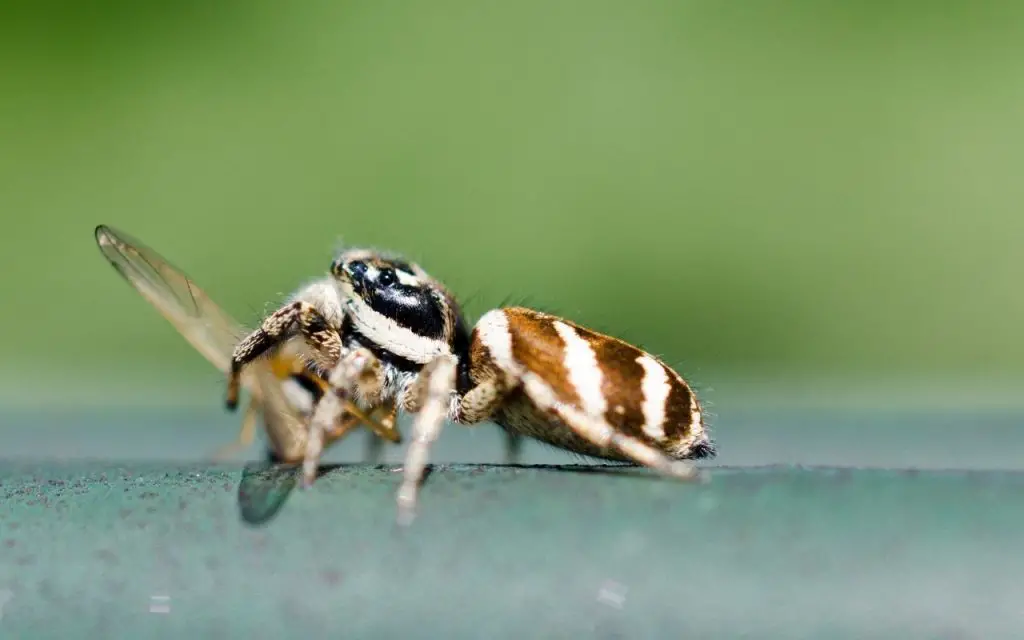
2. Green Jumper (Lyssomanes viridis)
The green jumping spider is among the smallest species in the family and it inhabits large leaves in warm and humid forests. You can spot them on magnolia tree leaves. However, they can also survive in dryer regions on oak trees.
They are common in the southern parts of the U.S like Alabama, Texas, Mississippi, etc. a mature male can grow to about 5 to 6 mm but the female is larger, measuring 7 to 8 mm in length.
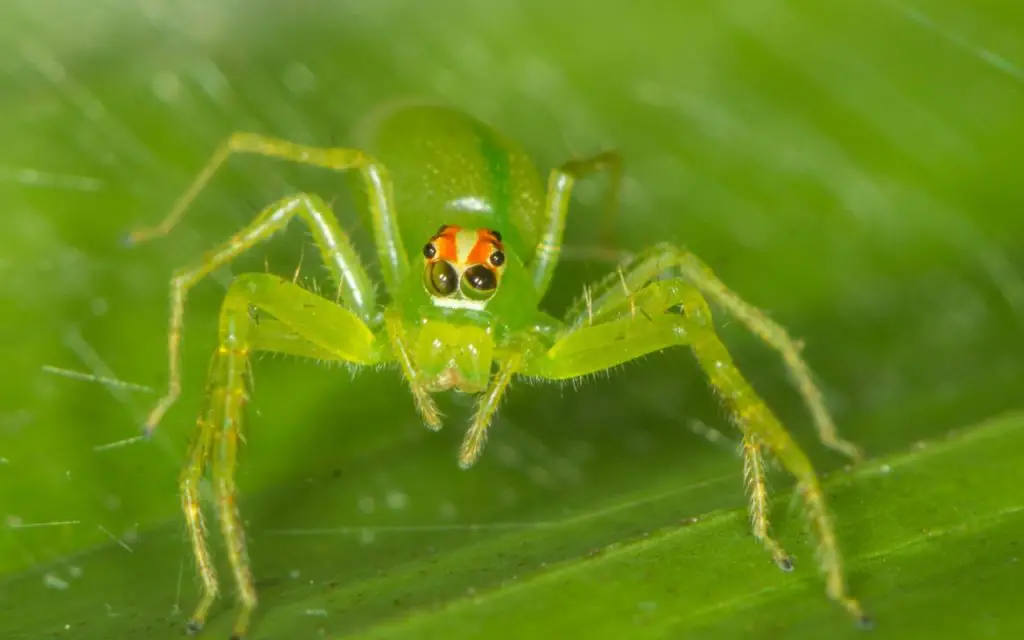
3. Cardinal Jumper (Phidippus cardinalis)
The cardinal jumper is a tiny jumping spider known for mimicking the mutilid wasps. They are native to Mexico and the eastern U.S.A, but you can find some in Panama. Like most jumpers, they use silken threads to catch their prey rather than build webs. The males are slightly tinier than their female counterparts.
4. Red-backed Jumping Spider (Phidippus johnsoni)
It is widespread in western North America and a frequent visitor in homes. However, sometimes you may mistake it for the venomous redback spider due to the red mark on its back. A mature one can grow up to about 1 cm long.
While both sexes have a red abdomen, the female displays an additional stripe in the middle of the red mark.
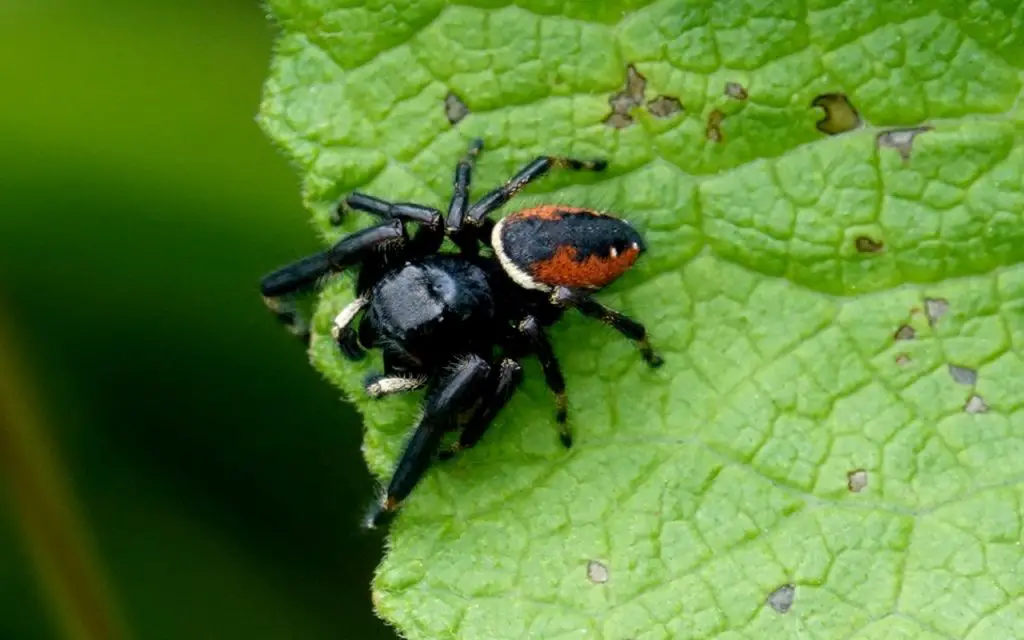
5. Shiny Jumping Spider (Cosmophasis Umbratica)
These jumpers are native to south east and south Asia where they dwell most on green vegetation. You can see extreme dimorphism when you view this creature under UV light. However, this only happens with mature males.
Unlike in other species, the males are much larger and brighter than the females. An adult male can be about 5 to 7 mm long while the females grow to about 4 to 5 mm.
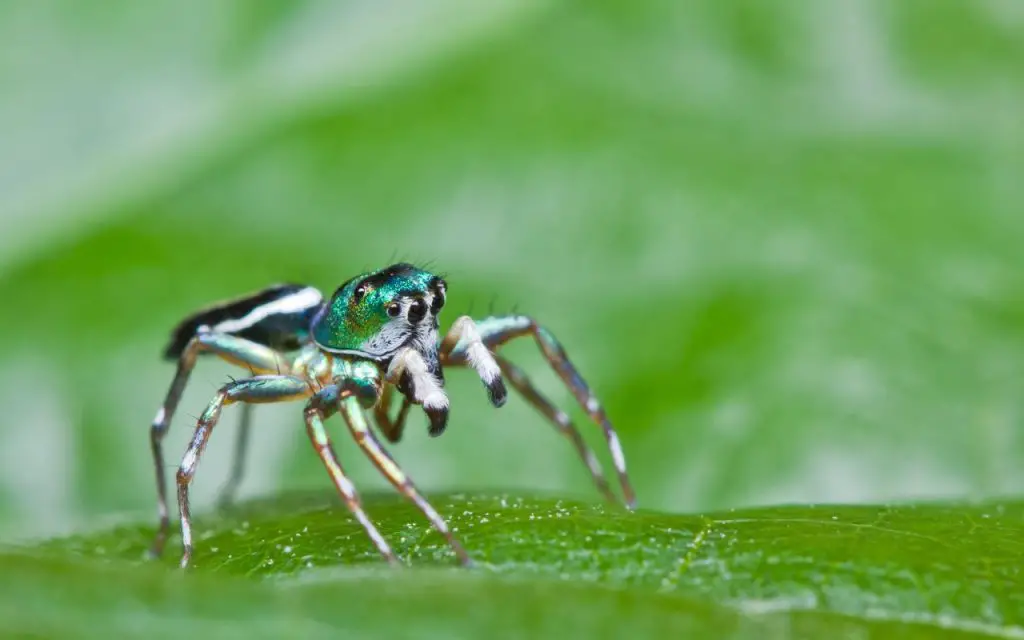
How big do jumping spiders get? Final Thoughts…
The jumping spider earns its name from its capabilities to observe its prey before jumping and pouncing on it. Most species in this family maintain their maturity sizes at medium, with a few growing up to 0.87 inches. Moreover, most species are friendly and harmless, but can attack when disturbed.

